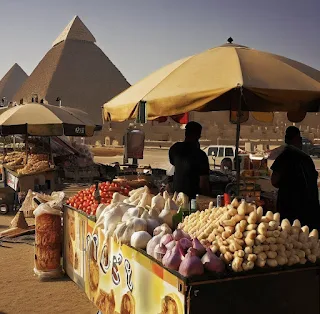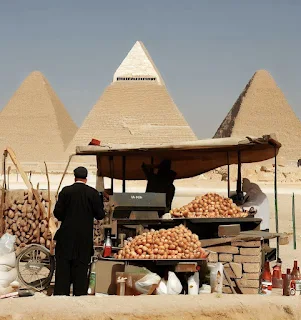Street Food History is Deep
Origins of street food in Africa is traced back to ancient times when laborers building the pyramids of Giza in Egypt consumed bread, onions, garlic, and beer from street vendors.
During the construction of the pyramids in Egypt, street food played a significant role in providing food to the workers involved in these monument building projects. The available historical evidence suggests that the workers relied on street vendors for their daily meals.
The street food sold during this time consisted of simple yet nourishing options that could be conveniently consumed on the go. One of the staple foods consumed by the pyramid builders was bread. Bread was a dietary staple in ancient Egypt, made from a combination of grains like wheat and barley.
Street vendors would sell freshly baked bread, which provided workers with a substantial source of carbohydrates for energy during their labor-intensive tasks. Alongside bread, other ingredients commonly found in the street food of that era included onions and garlic.
These vegetables were known for their nutritional value and flavorsome properties. Onions and garlic provided essential vitamins and minerals, adding both taste and health benefits to the workers' meals.
These ingredients were often used to enhance the flavor of the bread or as condiments for other foods. In addition to bread, onions, and garlic, it is believed that beer was also a part of the street food offerings for the pyramid builders. Beer was a significant component of the ancient Egyptian diet and was consumed regularly by people of various social classes.
Street vendors sold beer, and water providing workers with a refreshing beverage after a day of physical exertion. Based on archaeological findings and an understanding of the culinary traditions of ancient Egypt, bread, onions, garlic, and beer are among the common elements that would have constituted the street food available to the labors.
Later, the spread of Islam across North Africa introduced new ingredients and dishes, such as couscous, dates, nuts, and dried fruits. The trans-Saharan trade also facilitated the exchange of foodstuffs between different regions, such as salt, spices, grains, and meat.
The European colonization of Africa from the 15th century onwards had a profound impact on the food landscape of the continent. The introduction of crops such as maize, cassava, potatoes, tomatoes, and peppers from the Americas changed the diets and cuisines of many African peoples.
Some of these crops became staples for street food vendors, who adapted them to local tastes and preferences. For example, in West Africa, akara or fried bean cakes and puff-puff or fried dough balls are popular snacks made from corn or cassava flour.
In East Africa, chapati or flatbread and samosa, triangular pastry filled with meat or vegetables are influenced by Indian cuisine brought by immigrants and traders.
In these dynamic spaces, friendships are forged, stories are shared, and traditions are passed down from one generation to the next. Street food becomes a vessel for cultural exchange, as people from different backgrounds come together to celebrate the unique flavors and culinary heritage of Africa.
Importance of mobile food stalls in Africa from ancient times to today.
Mobile food stalls, also known as food carts or food trucks, are small portable units that sell a variety of food and beverages. Mobile food stalls encourage entrepreneurship and foster innovation in the food industry.
They provide a platform for aspiring chefs and culinary enthusiasts to showcase their skills, experiment with new recipes, and test the market demand for their offerings.
Mobile food stalls are equipped with cooking equipment, storage facilities, and serving counters, allowing vendors to prepare and serve food on the spot.
These stalls are designed to be easily transported to different locations, allowing vendors to serve customers in various settings such as street corners, festivals, events, or even outside office buildings.
The diversity of street food in Africa reflects the diversity of its people and cultures. Each country and region has its own specialties and variations that showcase its unique flavors and ingredients.
Mobile food stalls in Africa are important because compared to operating a brick-and-mortar restaurant, mobile food stalls typically have lower overhead costs. They don't require a dedicated building, reducing expenses such as rent, utilities, and property taxes.
Mobile food stalls help improve food accessibility, especially in areas with limited access to restaurants or grocery stores. They can reach remote or underserved communities, providing them with a variety of food options.
Starting a mobile food business requires a relatively low initial investment compared to opening a traditional restaurant, making it a viable option for individuals with limited resources.
Examples of popular street food found across Africa.
Jollof rice is a one-pot dish of rice cooked with tomatoes, onions, spices, and meat or fish. It is widely consumed in West Africa, especially in Nigeria, Ghana, and Senegal. Each country claims to have the best version of jollof rice.
Bunny chow is a hollowed-out loaf of bread filled with curry. It originated in South Africa among the Indian community during the apartheid era, when they were not allowed to use plates or cutlery in public places.
Suya are grilled skewers of meat usually beef or chicken marinated in a spicy peanut sauce. It is a popular street food in Nigeria and other parts of West Africa.
Moin Moin is a steamed cake made from blended black-eyed beans, onions, peppers, and palm oil. They are often wrapped in banana leaves or foil and sold by street vendors in Nigeria and other West African countries.
Mandazi is deep-fried doughnuts flavored with coconut milk, cardamom, and sugar. They are a common breakfast or snack item in East Africa, especially in Kenya, Tanzania, and Uganda.
Injera is a sourdough flatbread made from teff flour that is used as a staple and utensil in Ethiopian and Eritrean cuisine. It is served with various stews and salads that are placed on top of the injera and eaten by tearing pieces of it with one's fingers.
Biltong is dried and cured meat (usually beef or game) that is sliced into thin strips and seasoned with salt, pepper, vinegar, and spices. It is a traditional snack in South Africa that dates back to the early settlers who preserved meat without refrigeration.
Fufu is a starchy paste made from boiled and pounded cassava, yam, or plantain. It is eaten with various soups and sauces by dipping pieces of it with one's fingers. It is a staple food in many parts of West and Central Africa.
Street food in Africa is not only delicious, but it is rich in history and diversity, dating back to ancient times and infusing influences of African, Latin American, European, and Asian descent.
 Since 2007
Since 2007










Comments
Post a Comment
Thank you for the comment.